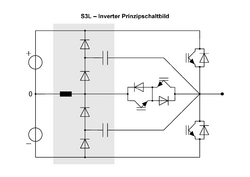Engineering:Soft-switching three-level inverter
A soft-switching three-level inverter (S3L inverter) is a high-efficiency power electronic inverter intended, in particular, for use with three-phase drives, as a grid-tie inverter for photovoltaic installations or wind turbines and in power supplies.[1] The topology was developed in 2009 at HTWG Konstanz (Constance University of Applied Sciences).
Operating principle
Inverters are used for converting DC voltage into AC voltage. Their construction typically makes use of power transistors and diodes. These are operated as electronic switches. In conventional designs using "hard" switching, this gives rise to switching loss (de)[2] which, especially for high values of the switching frequency, cause a reduction in their energy conversion efficiency. To improve their efficiency, high-power inverters (from about 10 kW) frequently make use of a technique referred to as a three-level design (three-level inverter).[3]
Forming the basis of the S3L inverter is a hard-switching three-level inverter of this kind with a T-type topology.[4] This base design is supplemented by a snubber circuit consisting of a few passive components.[5] It prevents the occurrence of simultaneously high values of voltage and current, and hence high power dissipation values, during the switching process. All switching processes therefore take place in a "soft" manner. In this way switching losses are largely avoided. Furthermore, because the snubber circuit functions, in principle, without losses, the conversion efficiency of the inverter remains high even for high values of the switching frequency.[6][7]
References
- ↑ "Reliance Electric GV3000 Drive 25V4160 | Automation Industrial" (in en). https://25v4160.com/blog.
- ↑ Peter R. W. Martin (editor): Applikationshandbuch IGBT- und MOSFET-Leistungsmodule. ISLE Verlag, 1998, ISBN:3-932633-24-5, Section 1.2.3 Qualitatives Schaltverhalten von MOSFET und IGBT beim harten Schalten (PDF version).
- ↑ Akira Nabae, Isao Takahashi, Hirofumi Akagi: A New Neutral-Point-Clamped PWM Inverter. In: IEEE Transactions on Industry Applications. IA-17, No. 5, 1981, pp. 518–523, doi:10.1109/TIA.1981.4503992.
- ↑ M. Schweizer, J. W. Kolar: High efficiency drive system with 3-level T-type inverter. In: Proceedings of the 2011-14th European Conference on Power Electronics and Applications (EPE 2011). 2011, ISBN:9789075815153, pp. 1–10.
- ↑ M. W. Gekeler: Soft switching three level inverter with passive snubber circuit (S3L inverter). In: Proceedings of the 2011-14th European Conference on Power Electronics and Applications (EPE 2011). 2011, ISBN:9789075815153, pp. 1–10.
- ↑ Manfred W. Gekeler: Weich schaltender 3-Stufen-Pulswechselrichter mit verlustfreiem Entlastungsnetzwerk. In: International ETG Congress 2011 (ETG Technical Report 130 Part B). 2011, ISBN:978-3-8007-3376-7, pp. 264-270.
- ↑ 3-Level Pulse Width Modulation Inverter with Snubber Circuit; US Patent No. US 8,462,524 B2; Date of Patent: Jun. 11, 2013; Inventor: Manfred W. Gekeler, Constance (DE); Assignee: Hochschule Konstanz, Constance (DE)
 |


